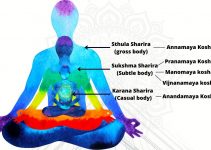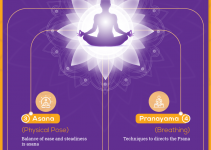
“Never producing pain by thought, word, and deed, in any living being, is what is called ahimsa, non-injury,”
– Swami Vivekananda’s work on Raja Yoga.
Life is simple, it’s us who make it complicated with our expectations. We are a tiny fraction of the entire reality. Our existence as a race is barely a percent of the aggregate.
In a broader sense, all our complex intellect is nothing but a manifestation of our mental construct. Our mind, despite being a part of this monumental reality, what goes on inside it, is mostly superficial.
Thus the truest form of living is not to horde more of earthly possession. There are far superior currencies in the universe, like kindness, harmony, and love.
The truest form of living is to harness such universal currencies and strive to unite with the spirit of the universe itself. Ahimsa is one such currency.
What is Ahimsa?
Ahimsa or Ahinsa, derived from the Sanskrit word ‘a’ = ‘not’ and ‘Himsa’ = ‘hurt’, is the act of nonviolence in your thoughts, speech, and actions, toward all living beings and yourself. It’s is often considered to be at the root of all other moral pursuits in different religions.
In Hinduism, the concept of Ahimsa is evolved from Vedic texts and its use has been seen in epic like Mahabharata. It’s said in Mahabharata, Ahimsa Paramo Dharma (अहिंसा परमॊ धर्मः) means “non-violence is the highest moral virtue”. According to Gandhi, who is called the father of nonviolence, Ahimsa generally has two forms; Passive and Physical. Passive ahimsa is what actions we do or go through in daily life, consciously and unconsciously. This passive Ahimsa itself gives birth to physical violence.
Moreover, in Jainism, the concept of Ahimsa has given uttermost importance and is seen linked with libration, free from the cycle of death and birth. According to Jainism, Ahimsa is the subtle quality of the soul and the only way to practice Ahimsa is to protect every other soul you came in contact with. Jains further extend this concept by implementing nonviolence not only to other beings but hurting one’s own self by any means of the act, thought or behavior is also considered Ahimsa. This is so because in the act of hurting one’s own self you inhibit the soul’s own ability to attain moksha.
The Yogic Concept of Ahimsa
The term Ahimsa was first used systematically around 400 CE, by the sage Patanjali, in his compilation work Yoga Sutras. The yoga sutras have since then been a classical manual of yogic practices.
Eight limbs of Yoga, which is one of the key teachings of Yoga Sutras, describe the journey of yoga contains eight basic steps. Ahimsa is the very first pillar of the foremost step of Yoga i.e. Yama. The 5 Yamas respectively are:
- Ahimsa – ‘Nonviolence’
- Satya – ‘Truthfulness’
- Asteya – ‘Non-stealing’
- Brahmacharya – ‘Continence’ or ‘Right use of energy’
- Aparigraha – ‘Non-attachment‘
Incorporating Ahimsa in real life seems very legitimate but in yoga, what is its significance? Well, cause of these core values of Ahimsa itself yoga is called ‘a way of lifestyle’. Without incorporating Ahimsa, not any single asana, pranayama, or hours of meditation practice can have real meanings. The importance of Ahimsa multifold for a seeker who wants to grow spiritually. One can truly expand one’s individual consciousness by imbibing the concept of ahimsa and then linked it with other yogic practices to manifest the universal consciousness.
Ahimsa in real world can be understood using below concepts;
1. Ahimsa in words
Verbal can cause immense emotional harm and even trauma to others. Verbal violence can not only hurt others, but it can set a chain of effects that will boomerang back to hit you hard.
Verbal abuse can be so harsh that it can literally make a person feel sick in the gut. Verbal ahimsa teaches us to be kind and loving with our words.
2. Ahimsa in Thoughts
Even the unspoken thoughts and thoughts not acted upon can be harmful, indirectly. It must be understood that all violent actions and words have some form of violent thought acting behind them.
Thus violent thoughts can warp your mind and initiate alternative passively violent words or actions, that can be equally hurting. Ahimsa teaches us to keep our thoughts free from all forms of animosity.
3. Ahimsa towards self
An important lesson of ahimsa is to be forgiving to oneself. It is often said if you are not kind to yourself, it will be difficult to be kind to others. If your mind is riddled with self-judgment, self-resentment, and anger, you will lack compassion.
4. Ahimsa in diet
Ahimsa although translates non-violence, the more literal translation would be Absence of injury. This means ahimsa is all such practices that aims to absolve injury from the universe. Ahimsa in diet is incorporating a food habit that is kinder to other living beings.
Veganism is a good example of ahimsa in diet. Some other alternatives to veganism include food habits based on humane treatment of animals and farming with low environmental footprint. Ahimsa in diet, most teaches us to be aware of the moral implications of our diet.
5. Ahimsa in state
War, economics, and politics are three major fronts of a state. Ahimsa teaches us to have economic and political policies that allow us to stay in harmony with other states.
The inability of ahimsa at state level leads to war, and with it an insufferable amount of life lose. Inability to establish ahimsa at state level also leads to large scale destructions that impact the entire ecosystem.
6. Ahimsa towards nature
This Finally brings us developing compassion towards nature. Ahimsa teaches how it should be our primary goal to preserve the ecosystem we live in. Care for the animals living alongside us and coexist with them in Harmony. And preserve the flora that provides for our survival. A reasonable and smart person will acknowledge that ahimsa is the most sensible and sustainable lifestyle.
Ahimsa in the yoga practice

Yoga asanas will primarily require two aspects of ahimsa; ahimsa of thoughts and ahimsa within self. Ahimsa will teach you to have a calm and composed mind. The idea of rush, hurry, and aggression will be absolved from your nature.
You will always be graced with a flowing stability, of mind and body. Ahimsa will prepare your mind to approach each Asana with awareness and steady movements. As a result will do no harm to yourself, from improper postures or movement.
For example, tricky poses like the bridge pose, or shoulder stands, can make you quite frustrated. Sometimes you may even rush your movements, only to hurt your soft tissues. With the practice of ahimsa you will have confronted all your limitations and inabilities. Tricky poses will not frustrated you, and you will not have the tendency to rush.
Yoga Asana Benefits from Ahimsa
The practice of ahimsa is a continuous process that will change your mind and body. This change is something you will notice very evidently, especially while practicing yoga asanas.
On incorporating Ahimsa in your practice,
- You will develop a flow in your pose build-up movements.
- You will not feel frustrated if you are not able to perform a pose at the first few attempts.
- You will build a tolerance for both mental and physical suffering.
- You will never feel agitated, this will help you maintain a stable breath cycle in your poses.
- A stable breath cycle will generate greater health benefits during the holds
- You will have increased awareness of your postures.
The challenge of practicing Ahimsa

The fundamental philosophy of ahimsa is very simple, do no harm, not in actions, not in words, and not in thoughts. The idea is so easy that even a 5-year-old could follow, but the implementation is so difficult that even 50-year-olds fail.
Ahimsa teaches you to absolutely rid your mind of animosity and aggression. And in order to do so, the fundamental requirement is that you will have to confront your greatest shortcomings. You will have to accept your inabilities and acknowledge your failures.
Confronting and accepting your own shortcomings is a mighty task, at which most fail. This is precisely why practicing ahimsa is a lifelong task. There is no shortcut to bypass it. You need to be driven by a true sense of purpose and motivated by a strong sense of commitment.
Practicing ahimsa changes your personality
Practicing ahimsa is a journey. And along this journey you will surely change as a human being, picking up new positive traits. Traits that will not only benefit you but others as well. Traits that will give you the power to make a difference in this world.
- You will become a living embodiment of peace and love.
- You will master the art of confrontation.
- You will be hardwired with dedication and commitment.
- You will develop mental strength.
- You will be courageous, and be confident enough to show it in time of need.
- You will strengthen your roots.
- You will have an upper hand over your shortcomings and insecurities.
- You will be patient and clairvoyant.
- Your interpersonal and intrapersonal skills will develop.
- And you will function with reduced stress and anxiety.
Philosophy of Ahimsa
Ahimsa as a term has great cultural relevance, especially in the Indian subcontinent. But the core essence of the term has always been relevant to mankind. Ahimsa, or non-violence as an idea is as old as life itself.
As human beings we have such high aspirations. Aspiration of a better career, of a better accommodation, of a better companion, and the list is tirelessly endless.
Just imagine the vastness of our universe; the universe has 1 billion trillion stars and is 13.8 billion years old. Just our world, earth, is 4.5 billion years old, with 374000 plant species and 8.7 million animal-like species (with 80% still undiscovered).
Amidst such vastness, what importance does the financial aspirations of a single human have? The only thing that makes sense that brings purpose to our existence, is to be one with the universe. And in the process preserve the universe, by being kind and loving. That is the philosophy of non-violence.
Anthropologically speaking, it is the sharing, caring and loving nature of homosapiens, that brought us where we are today. Every proud moment we have had in history or prehistory has been a result of some selfless act, generosity, or kindness. And every violent act has resulted in the fall of civilizations. Ahimsa is a force that preserves the universe, and us being a part of it, ahimsa preserves us as well.




